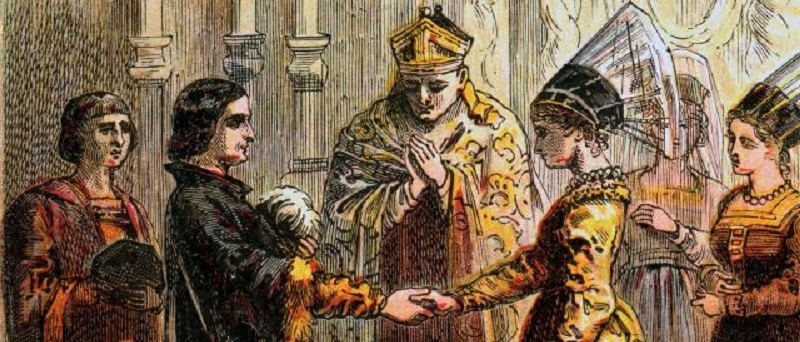Tudor Marriage
Posted on 23rd January 2021
Marriage in Tudor times was not about love, but convenience. Marriages were arranged by parents to improve social standing for the bride or increase wealth for the groom with the bride’s dowry. In royal families, marriages were also arranged to form political alliances with other countries.
If love did not grow after marriage, it was hoped that a mutual affection would develop.
As life expectancy in Tudor times was short, it was rare for there to be a life-long marriage, and women married numerous times, often within weeks of being widowed.
Men and women did not choose their own partners. In wealthy families, it was often the case that the bride and groom would only meet for the first time at the wedding, however in poorer families, although the partners were chosen by the parents, they would be given time to get to know each other before the wedding.
On average, the age of the bride was twelve and the groom fourteen, however in nobility marriages the children could be as young as three or four when promised in marriage. Sometimes sons from poorer families waited to marry until they were in their twenties and they had the ability and standing to support their own household.
The higher the social status, the less say was had in the choice of a partner and the younger they were wed.
In poorer families, daughters were married off early, to save the father the cost of providing for her. As well as saving the family money, this negated the worry of the daughter reaching an age where she would be classed as too old to marry.
Many marriages were simple affairs. You could be classed as married if the bride and groom stood in front of witnesses and named themselves as husband and wife, however noble marriages were much more elaborate affairs.
Once a woman was married, she was no longer allowed to wear her hair loose and was restricted to wearing both a veil and hood.
It was a wife’s priority to produce a son, and due to the high mortality rate in childbirth the wife would spend most of her time pregnant. As one birth took place, the wife would be pregnant again within weeks of the birth. It was hoped that at least some of the children would grow into adulthood.
A family would often use the same name for a son on more than one occasion. If a son died in infancy the next son would often be given the same name, and sometimes therefore there may be many sons from the same marriage with the same name.
Childbirth was also dangerous for the mother with as many as 20% of women dying while giving birth. There were no proper doctors, so pregnant women were assisted by an elderly female relative that acted as a midwife. As these women were untrained, hygiene and cleanliness were not treated as important and many women in childbirth suffered from infections and died.
To have a successful marriage in Tudor times was to produce at least one son to live to adulthood and also to obey the husband.
Tagged as: Junior Tudors
Share this post:





